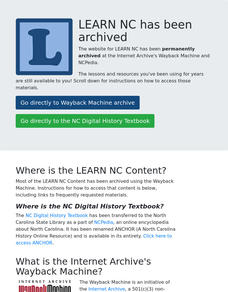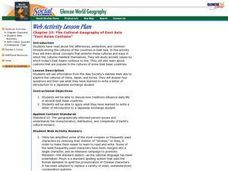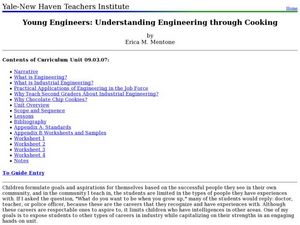Curated OER
Asian, African, or Australian Inventors & Inventions
Seventh graders explore the inventors or inventions from Asia, Africa, and Australia.
Curated OER
GEOGRAPHY OF FOOD & FIBER
Students will explain the ways geography determines the crops grown in the United States and other countries, and the resulting trade relationships.1. Discuss trade routes, both ancient and current. Discuss why the most direct route from...
Curated OER
Haiku and Beyond: Exploring Genres of Japanese Literature
Fourth graders compare and contrast the literature of Japan as they study the culture, history and geography of the island nation. They read various genres of literature, describe geographic and landform features of Japan, and find...
Curated OER
Teaching About East Asia
Seventh graders research East Asian countries. In groups, pupils are assigned to research China, Japan or Korea. Using the internet and other resources, classmates create a multiple tier time line. They consider aspects such as...
Curated OER
The Old North Trail
Students engage in a lesson to find information about the old trails of North America that were used by Native Americans. Specifically, they conduct research to find the history of The Old North Trail. The teacher shares several theories...
Curated OER
The Cultural Geography of East Asia
Students use information from the Asia Society's AskAsia Web site to explore the cultures of China, Japan, and Korea. They answer four questions and then use what they have learned to write a letter of introduction to a Japanese exchange...
Curated OER
"Medieval Travels, The Mongols and the Silk Road Across Asia"
Eleventh graders are able to take information obtained from the various readings of primary and secondary sources and classroom discussions directed by the instructor and relate it to the student's curretn real life experiences. They...
Curated OER
China's Ethnic Minorities
Third graders are introduced to various Chinese ethnic groups. They consider how geography affects ethnic groups and examine artifacts produced by Chinese peoples. They prepare a presentation of their research and artifact interpretation.
Curated OER
Fujiyama
Students examine and discuss Mt. Fuji (Fujiyama) and its effect on the culture and philosophy of Japan. This high school lesson is ideal for a Social Studies, Humanities, or Asian Studies class.
Curated OER
Writing & Language
Students examine Chinese and East Asian writing characters. They discuss how their writing systems differ from others found in the world. They practice reading and pronouncing Chinese and Japanese names and words.
Curated OER
Haniwa
Students use non-fired clay and posterboards to create and display examples of Haniwa and kofun in this exciting lesson for the Social Studies, Humanities, Asian Studies, or Art classroom.
Curated OER
The Daoist Immortals
Students discover the basic principles and beliefs of Daoism through investigation and in-class discussion in this High School lesson for a Social Studies, Humanities, or Asian Studies class.
Curated OER
Scenes of Reverence: The Virgin of Guadalupe
Students learn the history of Christianity in New Spain. They learn the story and significance of the Virgin of Guadalupe. They compare and contrast images of the Virgin and religious art to European counterparts.
Curated OER
Explore Learning Exponential Functions
High schoolers graph exponential equations and solve application problems using exponential functions. They re-enact a story about a peasant worker whose payment for services is rice grains doubled on a checker board. They place M &...
Curated OER
Exponential Functions
Students graph exponential equations of the form y=Ma. They understand the effects of M, a, and k on the graph. They solve application problems using exponential functions.
Curated OER
Tracing Genetic Ancestry Using DNA Microarrays
High school learners read and discuss an article about genetic ancestry and genetic ancestry testing. They complete a paper and pencil activity that mimics the function of a DNA microarray and consider the ethics of genetic testing in...
Foreign Policy Research Institute
A Geography Lesson
Fewer and fewer people have a strong grasp of world geography, but this activity helps students understand geopolitics by creating their own original historical map. The activity requires selecting a country from the list provided,...
Curated OER
Nataraj Shiva as Lord of the Dance
Students considers the piece of artwork entitled, The Nataraj, Lord Shiva and Lord of the Dance to visualize several of the most important ideas of Hinduism.
Curated OER
Dying to Look Good!
In this health worksheet, students examine how people have done unhealthy things to their skin in order to look fashionable. Students read about Elizabethan women putting toxins on their skin to make themselves pale. Then students read...
Curated OER
Mediterranean Trade in the Late Bronze Age
Seventh graders analyze the amount and conditions of trade in the late Bronze Age. In groups, they research where a variety of items and goods originated. They participate in Mediterranean trade days in which they try to acquire as...
Curated OER
Young Engineers: Understanding Engineering Through Cooking
Second graders explore different engineering careers. In this math lesson plan, 2nd graders create a winning cooking recipe. They role play a mock cookie sale during the culminating event.
Curated OER
In Perfect Harmony: Teaching the World to Sing
First graders listen to music as the impetus to learn about the concept of Japanese harmony as it is understood in Japanese culture. They use the New Seeker's song, "I'd Like to Teach the World to Sing," to compare America and Japan...
Curated OER
Origami Paper Fun
Pupils explore the art of Origami. They listen to various stories about Japan, create Origami shapes by following step-by-step directions, sing Japanese songs, locate Japan on a map, and take a quiz.
Curated OER
Guidelines for Governing: Utopia and The Prince
Students explore the power of the Church in government. In this literature lesson, students read Sir Thomas More's Utopia and Niccolo Machiavelli's The Prince. Students respond to questions regarding the works and discuss them.

























